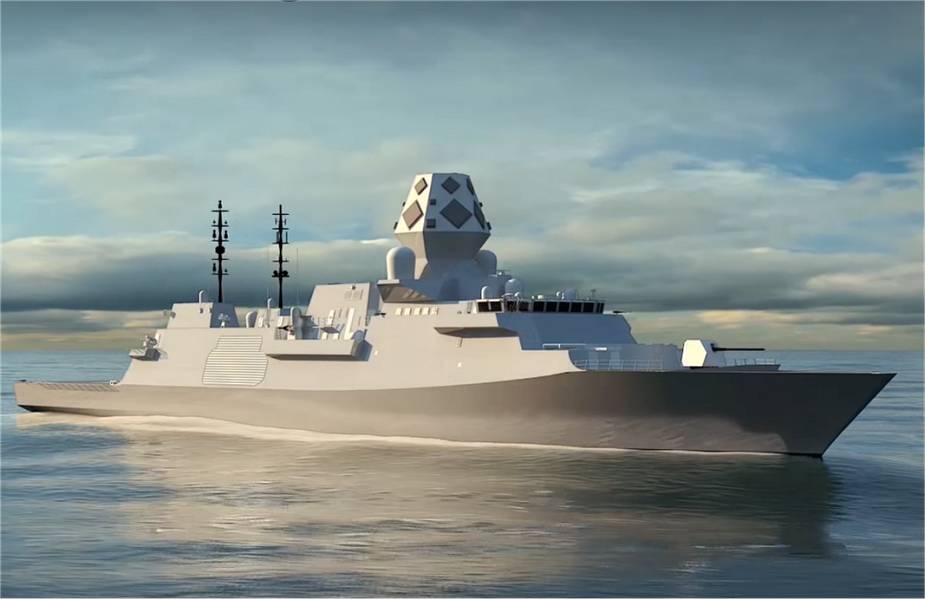ASC Shipbuilding from Australia has signed a $2.6 million contract with BlueScope Steel AIS for the Hunter Class Frigate Program for the Royal Australian Navy. Under the contract announced last week, Australian company BlueScope will supply more than 1500 tonnes of steel plate to build five blocks during the prototyping phase of the shipbuilding program, which is on track to begin later this year.
ASC Shipbuilding from Australia has signed a $2.6 million contract with BlueScope Steel AIS for the Hunter Class Frigate Program for the Royal Australian Navy. Under the contract announced last week, Australian company BlueScope will supply more than 1500 tonnes of steel plate to build five blocks during the prototyping phase of the shipbuilding program, which is on track to begin later this year.
Follow Navy Recognition on Google News at this link
 An artist's impression of the Hunter Class frigate for the Australian Navy. (Picture source BAE Systems video footage)
An artist's impression of the Hunter Class frigate for the Australian Navy. (Picture source BAE Systems video footage)
The construction of the blocks will test processes, systems, tools and facilities, as well as provide practical training opportunities for Australian workers. Managing Director of ASC, Craig Lockhart, said the contract signing was the first of many that would be awarded to Australian businesses in the coming months. ASC is BAE Systems Australia’s shipbuilding business and prime contractor for the program.
On December 14 2018 the Australina Government signed the Head Contract with ASC Shipbuilding Pty Ltd, a subsidiary of BAE Systems Australia Ltd, to build the Hunter class frigates under Project SEA 5000 Phase 1.
The Hunter Class Frigate Program (HCFP) will provide nine frigates optimised for anti-submarine warfare to replace the Anzac class frigates based on the UK’s Type 26 Global Combat Ship, modified to meet Australian requirements.
The HCFP is a multi-billion dollar program with the Government having approved the initial budget of $6 billion for the design activity to incorporate the Australian requirements, to conduct prototyping of ship blocks in the new shipyard under construction at Osborne in South Australia, and to order long-lead items for the first three ships.
ASC Shipbuilding and BAE Systems Australia are implementing a strategy to maximise opportunities for small to medium Australian suppliers in the build and sustainment phases (including their current supply chains).
The Hunter class frigate incorporates years of investment in digital design techniques and is an evolution of the Type 26 frigate, which is currently being constructed in Glasgow, Scotland, for the United Kingdom's (UK) Royal Navy. It will incorporate the leading-edge Australian CEA phased-array radar and the Aegis combat management system with a Saab-designed interface built specifically for Australia. The Hunter class frigate will be one of the most advanced digitally-designed, anti-submarine warships in the world, providing world-class capability to the Australian Navy.
Ships will be constructed on acoustically-quiet hulls and feature unique sonar capabilities, modular digital design and open systems architecture to facilitate through-life support and upgrades as new technology develops. The frigate is the world’s first bow-to-stern digitally-designed, anti-submarine warfare warship. Teams across Australia and the UK are working closely to complete the design work necessary to tailor the Hunter frigate to the Royal Australian Navy’s operating requirements.
The Hunter has been designed for maximum versatility and flexibility in operational roles, from humanitarian and disaster relief operations to high-intensity warfare. The integrated mission bay and hangar is capable of supporting multiple helicopters, unmanned vehicles, boats, mission loads and disaster-relief stores. A launcher can be provided for fixed-wing unmanned operations, and the flight deck is capable of landing a Chinook helicopter to transport land forces.







